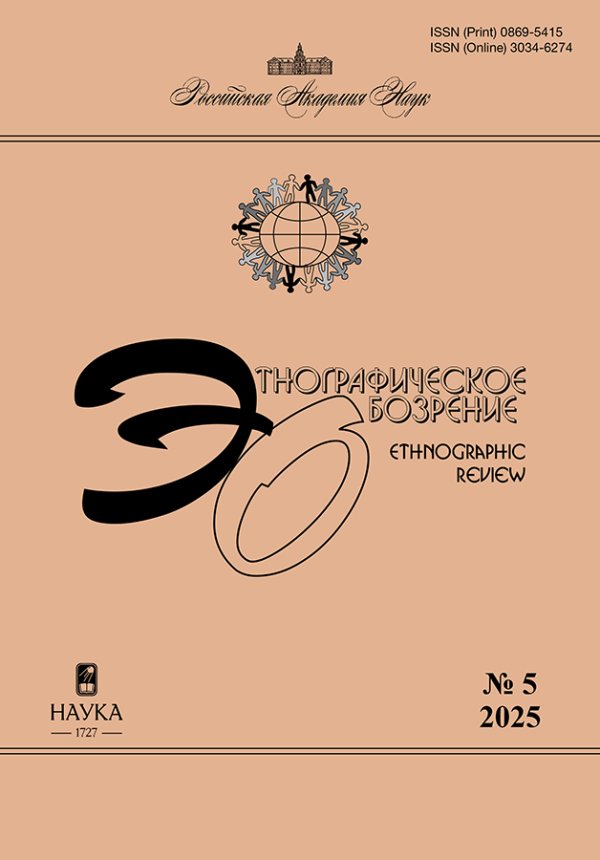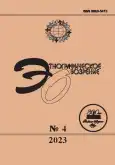The “kirat religion” in Nepal: quest for a new religious and ethnic identity
- Authors: Streltsova L.A1
-
Affiliations:
- St. Petersburg University
- Issue: No 4 (2023)
- Pages: 66-83
- Section: Articles
- URL: https://journals.rcsi.science/0869-5415/article/view/142109
- DOI: https://doi.org/10.31857/S0869541523040048
- EDN: https://elibrary.ru/HIXVTO
- ID: 142109
Cite item
Full Text
Abstract
Keywords
About the authors
L. A Streltsova
St. Petersburg University
Email: liliboridko@gmail.com
St. Petersburg, Russia
References
- Альбедиль М.Ф., Стрельцова Л.А. Непал. Как сохранить веру предков? // Азия и Африка сегодня. 2022. № 6. С. 58-65. https://doi.org/10.31857/S032150750020423-7
- Толстой Н.И. Очерки славянского язычества. М.: Индрик, 2003.
- Успенская Е.Н. Антропология индийской касты. СПб.: Наука, 2010.
- Allen N. Shamanism among the Thulung Rai // Spirit Possession in the Nepal Himalayas / Ed. J.T. Hitchcock, R.L. Jones. Warminster: ARIS & PHILLIPS, 1976. P. 124-140.
- Chemjong D.D. "Limbuwan is Our Home-Land, Nepal is Our Country": History, Territory, and Identity in Limbuwan's Movement. PhD diss. abstract. Cornell University, 2017.
- Chemjong I.S. History and Culture of the Kirat People. Kathmandu: Kirat Yakthung Chumlung, 2003.
- Gaenszle M. The Kiranti Groups of East Nepal // Contemporary Society: Tribal Studies. Vol. V, The Concept of Tribal Society. New Delhi: Concept Publishing Company, 2002. P. 31-56.
- Gaenszle M. Where the Waters Dry up - the Place of Origin in Rai Myth and Ritual // Origins and Migrations in the Extended Eastern Himalayas / Eds. T. Huber, S. Blackburn. Leiden: Brill, 2012. P. 33-47. https://doi.org/10.1163/9789004228368_004
- Gaenszle M. The Power of Script: Phalgunanda's Role in the Formation of Kiranti Ethnicity // Routeing Democracy in the Himalayas / Eds. Vibha Arora, N. Jayaram. New Delhi: Routledge India, 2013. P. 50-73. https://doi.org/10.4324/9780367818463-4
- Gaenszle M. Redefining Kiranti Religion in Contemporary // Religion, Secularism, and Ethnicity in Contemporary Nepal / Eds. D.N. Gellner, S.L. Hausner, C. Letizia. New Delhi: Oxford University Press, 2016. P. 326-352.
- Gellner D., Shrestha B.G. Limbu Adaptations of Religion in the Diaspora // Global Nepalis: Religion, Culture, and Community in a New and Old Diaspora / Eds. D.N. Gellner, S.L. Hausner: Oxford University Press, 2018. Р. 332-359.
- Gustavsson L. Religion and Identity Politics in the Indian Himalayas: Religious Change and Identity Construction among the Limboos of Sikkim. MA Thesis. Department of Culture Studies and Oriental Languages, University of Oslo, 2013.
- Hodgson B.H. Miscellaneous Essays Relating to Indian Subjects. L.: Truner & Co, 1880.
- Höffer A. The Caste Hierarchy and the State in Nepal: A Study of the Muluki Ain of 1854. Kathmandu: Himal Books Classic, 2012.
- Jones R.L. Sanskritization in Eastern Nepal // Ethnology. 1976. Vol. 15. No. 1. P. 63-75.
- Kainla B. Nawacait Mundhum. Kathmandu: Limbu Sahitya ra Sanskriti Utthan tatha Prakash Samaj, 2004. (неп. яз.)
- Limboo K.B. Limboos of Sikkim. New Delhi: Tarun Advertising Agency, 2003.
- Limbu B.B. Mangenna in Limbu Community: Ritual Text and Its Social-Cultural Values. MA Thesis. Central Department of English, Tribhuvan University, 2010.
- Limbu M. Delinking, Relinking, and Linking Writing and Rhetorics: Inventions and Interventions of the Sirijanga Syllabary. STAR Scholars Paperback. 01.03.2021.
- Sagant P. The Dozing Shaman: The Limbus of Eastern Nepal. New Delhi: Oxford University Press, 2008.
- Schlemmer G. Following the Ancestors and Managing the Otherness // Encyclopedia of the Religions of Indigenous People of South Asia / Ed. M. Carrin. Leiden: Brill, 2019. halshs-02303985
- Schlemmer G. New Past for the Sake of a Better Future: Re-Inventing the History of the Kirant in East Nepal // European Bulletin of Himalayan Research. 2003. No. 25/26. P. 119-144.
- Sthaneshwar T. Songs of Transformation: Vernacular Josmanī Literature and the Yoga of Cosmic Awareness // International Journal of Hindu Studies. 2010. Vol. 14. No. 2/3. P. 201-228.
- Subba C. Limbu Culture and Religion. Kathmandu: K.B. Subba, 1995.
- Subba J.R. History, Culture and Customs of Sikkim. Sikkim: Gyan Publishing House, 2008.
- Subba J.R. Mythology of the People of Sikkim. Sikkim: Gyan Publishing House, 2009.
- Subba T.B. Politics of Culture: A Study of Three Kirata Communities in the Eastern Himalayas. Chennai: Orient Blackswan, 1999.
- van Driem G.L. A Grammar of Limbu. Amsterdam: Mouton de Gruyter, 1987.
Supplementary files










